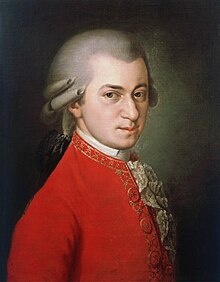
A | B | C | D | E | F | G | H | CH | I | J | K | L | M | N | O | P | Q | R | S | T | U | V | W | X | Y | Z | 0 | 1 | 2 | 3 | 4 | 5 | 6 | 7 | 8 | 9

Wolfgang Amadeus Mozart wrote Symphony No. 30 in D major, K. 202/186b[1] in Salzburg, completing it on 5 May 1774.
The work is scored for two oboes, two horns and two trumpets in D (silent in the Andantino and Trio), timpani and strings, but the timpani part has been lost.[2] There has been at least one attempt to reconstruct the timpani part.[3]
The work is in 4 movements:
- Molto allegro, 3
4 - Andantino con moto (A major), 2
4 - Menuetto and Trio (the latter in G major), 3
4 - Presto, 2
4
The first movement is in sonata form and opens with a falling, dotted fanfare motif.[4] A transitional section follows which contains a dialogue between violins and bass alternating between loud and soft dynamics and ending with a trill. The second theme a group of the sonata-form structure contains two sections. The first is a ländler scored for two violins against bass while the second is a minuet for the tutti featuring trills on almost every beat.[4] The expositional coda returns to the ländler style. The development focuses on the minuet style with the phrase-lengths elongated. Following the recapitulation, the movement coda returns to this minuet and regularizes its phrase lengths before the final cadence.[4]
In the trio of the minuet, the first violin is syncopated an eighth note ahead of the accompaniment.[4]
The finale starts with a falling dotted fanfare motif similar to the one that starts the opening movement. The answering phrase and the movement's second theme have a contradanse character.[4]
References
- ^ Ludwig Ritter von Köchel, Franz Giegling, Alexander Weinmann & Gerd Sievers, Chronologisch–thematisches Verzeichnis sämtlicher Tonwerke Wolfgang Amadé Mozarts, 6th ed. Wiesbaden: Breitkopf & Härtel (1964): 203.
- ^ Cliff Eisen, "Symphonies" The Mozart Conpendium, ed. H. C. Robbins Landon. London: Thames & Hudson (1990): p. 261
- ^ Robert Dearling. The Music of Wolfgang Amadeus Mozart: The Symphonies (Rutherford, Madison, Teaneck, Farleigh Dickinson University Press, 1982), p. 203: "A reconstructed timpani part is provided in which the timpani plays in each of the movements except the slow movement."
- ^ a b c d e Brown, A. Peter, The Symphonic Repertoire (vol. 2). Indiana University Press (ISBN 025333487X), pp. 379–381 (2002).
External links
- Symphony in D K. 202: Score and critical report (in German) in the Neue Mozart-Ausgabe
- Symphony No. 30: Scores at the International Music Score Library Project
Text je dostupný za podmienok Creative Commons Attribution/Share-Alike License 3.0 Unported; prípadne za ďalších podmienok. Podrobnejšie informácie nájdete na stránke Podmienky použitia.
Antropológia
Aplikované vedy
Bibliometria
Dejiny vedy
Encyklopédie
Filozofia vedy
Forenzné vedy
Humanitné vedy
Knižničná veda
Kryogenika
Kryptológia
Kulturológia
Literárna veda
Medzidisciplinárne oblasti
Metódy kvantitatívnej analýzy
Metavedy
Metodika
Text je dostupný za podmienok Creative
Commons Attribution/Share-Alike License 3.0 Unported; prípadne za ďalších
podmienok.
Podrobnejšie informácie nájdete na stránke Podmienky
použitia.
www.astronomia.sk | www.biologia.sk | www.botanika.sk | www.dejiny.sk | www.economy.sk | www.elektrotechnika.sk | www.estetika.sk | www.farmakologia.sk | www.filozofia.sk | Fyzika | www.futurologia.sk | www.genetika.sk | www.chemia.sk | www.lingvistika.sk | www.politologia.sk | www.psychologia.sk | www.sexuologia.sk | www.sociologia.sk | www.veda.sk I www.zoologia.sk

